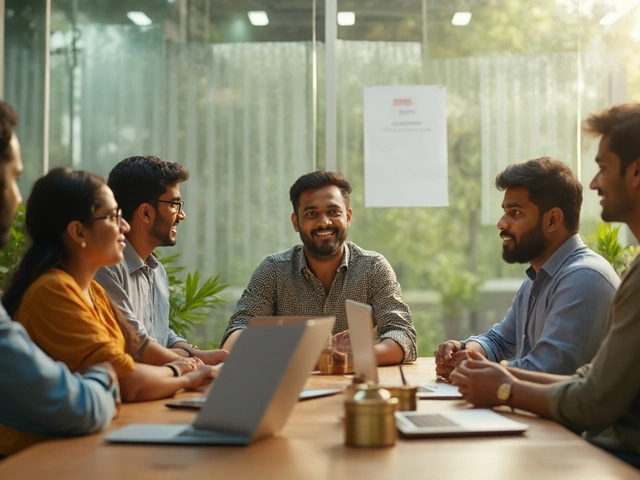Imagine wanting to pick up the guitar, learn Photoshop, or speak enough Spanish for a trip, but you keep putting it off because it sounds overwhelming. Everyone throws around that '10,000 hours to master anything' quote—no wonder most of us never get started. But here's the kicker: you don’t need to become a world-class expert. You just want to be good enough to get going, right?
The 20 hour rule is brutally simple. If you spend about 20 focused hours practicing almost anything, you’ll get surprisingly decent. That's not weeks locked away in a room—just under an hour a day for a month if you break it down. Think of it as jump-starting your skills instead of endlessly preparing or waiting for 'the right time.'
This method isn’t about shortcuts or some weird life hack. It’s the opposite of pulling out motivational posters. It’s about doing the work, just not forever. With a game plan and clear focus, anyone can get over the hump from 'I have no clue' to 'Hey, I can actually do this.' Most people spin their wheels right at the start, never getting even average. The 20 hour rule is your exit ramp off that frustrating loop.
- What Exactly Is the 20 Hour Rule?
- Why Most People Get Stuck Starting
- How the 20 Hour Rule Flips the Script
- What 20 Hours of Practice Looks Like
- Common Mistakes to Avoid
- Tips for Making Your 20 Hours Count
What Exactly Is the 20 Hour Rule?
The 20 hour rule comes from Josh Kaufman, an author and researcher who wanted to get better at skills fast without dedicating years. He found that to go from knowing nothing to being pretty competent, it typically only takes about 20 focused hours of practice – not months or years. The rule is completely against the old 10,000-hour myth, which claims you have to practice for years to be an 'expert.' Most of us even stop before we get past the awkward beginner phase, so we never see real progress.
Here’s the kicker: You're not aiming for mastery. The goal is to get just 'good enough' to use a skill in real life, whether that's playing a song, having a short conversation in another language, or editing videos for your side hustle. It's a way to fast-track the basics and skip the usual frustration that makes people quit.
Kaufman's approach is about focused, deliberate practice. He found that spreading those 20 hours out helps your brain actually pick up new habits. If you practice for about 45 minutes a day, you can hit the 20-hour mark in less than a month.
| Activity | Average Time to "Good Enough" |
|---|---|
| Basic guitar chords | 15-20 hours |
| Conversational Spanish | 20 hours |
| Basic website design | 15-25 hours |
| Touch typing (40 wpm) | 18-22 hours |
Don’t confuse this with cramming. 20 hours isn’t about hustling for a weekend then forgetting everything by Monday. It’s a real investment, but it’s doable for someone with a job, family, and, let’s be honest, other distractions. No special talent required—just a plan, a commitment, and, honestly, a willingness to suck a little at first before things click.
The trick is to cut out everything that doesn’t matter and zero in on the core stuff you actually need. If you can carve out a focused window every day, 20 hours is all it takes to go from zero to pretty solid.
Why Most People Get Stuck Starting
Most of us have a mental block at the starting line. It’s not laziness—it’s just human nature. The biggest problem? We overestimate what it takes to get started and underestimate how much progress we could actually make with focused effort. Tons of people hear that 'expert' buzzword and think, “If I can’t master this, why even try?” It’s a buzzkill before you even pick up a book or a guitar.
Here’s what usually holds people back:
- Fear of looking foolish: No one likes feeling clueless, especially adults. We’re used to being good at things we do day-to-day, so starting from scratch feels awkward.
- Perfectionism: It’s tempting to wait for the perfect conditions—new gear, spare time, the right tutorial—so you never actually get going.
- Hidden costs: People think learning a new skill needs expensive tools, lots of space, or formal lessons, so the mental price tag gets too high and they bail.
- Misinformation: The '10,000 hour rule' myth tells you that anything worth learning is out of reach unless you can grind for years. For regular folks, it just doesn’t fit real life.
- Lack of a clear plan: Without a concrete way forward, starting feels overwhelming and confusing.
Take a look at how this hesitation plays out. According to a 2023 survey from Coursera, 64% of adults say they want to learn a new skill, but only 17% actually sign up for a beginner course during the year. That’s a huge drop-off.
| Reason for Not Starting | % of Respondents (2023) |
|---|---|
| No time | 41% |
| Too expensive | 23% |
| Fear of failure or embarrassment | 18% |
| Information overload | 12% | No clear starting point | 6% |
The kicker? Most of these reasons crumble when you actually try the 20 hour rule. Instead of endless planning or waiting for a perfect moment, you just carve out a tiny chunk of time and get moving. You end up learning way faster than expected—just by showing up and giving yourself permission to be a beginner.
How the 20 Hour Rule Flips the Script
The 20 hour rule throws out the typical "slow and steady wins the race" mindset for picking up new skills. Instead of waiting to feel ready or piling on excuses, it asks, "What if you just spent 20 focused hours actually doing the thing?" It’s the difference between talking about wanting to learn, and actually getting your hands dirty.
One key fact: the 20 hour rule is built on research by Josh Kaufman. He studied how long it takes adults to get 'good enough' at something to enjoy it or use it practically. Forget mastery—this is about becoming comfortable, not winning awards. According to Kaufman and other learning experts, rapid improvement happens in the earliest hours of practice, not after years of grinding.
Most people quit early because of frustration or expecting results way too soon. The 20 hour rule flips the focus from "perfect" to "progress you can feel." By ditching the idea that you need thousands of hours or fancy gear, this rule says you can get real results fast if you focus and stick to a plan—even with a busy schedule or family chaos (honestly, I learned basic video editing in the early mornings before Nina even woke up!).
Let’s check out what happens to your skill growth when you start practice versus later stages. Look at this:
| Hours Practiced | Average Improvement (%) |
|---|---|
| 1-20 | Rapid Leap (about 50-70% of max basic skill) |
| 21-100 | Slower climb (10-20% more) |
| 100+ | Small gains with lots more effort |
The steepest jump happens in the 20 hour rule window. These first 20 hours can feel awkward, but once you're past that, you’ve got momentum and confidence. That’s why the method works—real progress, right away.
The script gets flipped: don’t obsess over mastery, obsess over getting through those first 20 hours. That’s where the real change happens.

What 20 Hours of Practice Looks Like
The idea behind the 20 hour rule sounds great, but what does it really mean for your day-to-day? Basically, you’ll need to break down those 20 hours into smaller, regular sessions so you actually stick with it and stay pumped. That usually means doing something like 40 minutes a day for a month, but you can mix it up as long as you end up with 20 hours total.
Josh Kaufman, the bestselling author who brought the 20 hour rule into the spotlight, puts it this way:
“The barrier to learning something is not intellectual… it’s emotional. The major barrier to skill acquisition isn’t knowing what to do, it’s doing it.”
So, the first few hours will feel awkward. You’ll mess up, get frustrated, and probably consider quitting. That is totally normal—everyone hates that ‘I suck at this’ feeling at the start. The real trick is to keep going, even when you want to throw the towel in.
Here’s what a 20-hour practice timeline could look like:
- Hours 1–3: Getting familiar, searching YouTube, messing up a lot.
- Hours 4–7: Repeating basics, starting to figure out what you keep doing wrong.
- Hours 8–14: Noticing tiny improvements, maybe even small wins (your first full song on guitar, basic photo edits that don’t look terrible).
- Hours 15–20: Actually having fun, being able to freestyle a bit, surprising yourself that you’re not awful anymore.
Your motivation will spike here—when you push through those first tough hours, the payoff is seeing real progress you can’t ignore. If you can, keep a journal or shoot some videos showing your day-one attempts versus where you end up. The difference is usually huge.
Here’s a rough timeline showing what happens during those 20 hours, based on data from folks who’ve tried it for stuff like coding, public speaking, and learning new instruments:
| Stage | Hours Spent | Main Focus | Common Feelings |
|---|---|---|---|
| Starting Out | 1–3 | Exploring, messing up | Frustration, self-doubt |
| Settling In | 4–7 | Repetition, correction | Annoyed but curious |
| Breakthroughs | 8–14 | Small wins, flow starts | Hope, pride |
| Comfort Zone | 15–20 | Pushing limits | Confidence, motivation |
To make those 20 hours count, set up an easy plan that fits your life. Choose a fixed time every day or a weekend blitz if you’re busy. Remove as many distractions as you can—phone off, TV off, just you and the skill. You’ll get the biggest returns if you stick it out past that ugly starting phase. That’s when the magic actually starts to happen.
Common Mistakes to Avoid
Lots of people get pumped up about the 20 hour rule but then run into the same roadblocks. It's way too easy to waste that practice time or get discouraged before you even see progress. Here’s what you want to watch out for if you actually want your time to count.
- Jumping in with zero plan: People often just start messing around, hoping something sticks. You need a plan for your practice or you’ll end up repeating the same basic mistakes for hours. Set a clear goal, like, “I want to be able to hold a simple conversation in Spanish,” and break it into steps.
- Multitasking or constant distractions: Those twenty hours won’t do much if you’re checking your phone or watching TV in the background. Research from Stanford University even found that multitasking can actually slow down skill-building. Cut out the distractions and focus on the task—it’s just one hour a day.
- Overloading your first few sessions: Cramming too much in or burning out right away is a fast way to quit. Spread the time out, and don’t expect miracles in the first hour. Skill learning is like going to the gym: steady and consistent beats a single monster session every time.
- Ignoring feedback: If you keep making the same mistake but never check in (with a coach, a friend, or even just online videos), you’ll cement that mistake. Honest feedback—either from others or from carefully watching yourself—changes the game.
- Comparing yourself to experts: The quickest way to get frustrated is to judge your early progress against someone’s years of experience. Remember, the 20 hour rule is about getting over the beginner stage, not instantly being a pro.
- Stopping right before the breakthrough: This one happens a lot. People bail when things start getting hard or boring, but a little push past that discomfort is usually where you actually improve. Don’t walk away just as it starts to stick.
Keeping these pitfalls in check means every hour you spend learning a new skill counts way more. Catch yourself early if you start slipping into any of these patterns—you’ll thank yourself after hour 20.
Tips for Making Your 20 Hours Count
The 20 hour rule sounds simple, but using that time well makes all the difference between just messing around and actually picking up a skill. Here’s how to get the most bang for your buck with every single minute.
- Break skills into chunks. Don’t treat anything as one endless thing to learn. Let’s say you want to play guitar: focus on 3-5 basic chords first, not the entire songbook of your favorite band. Make a list of the building blocks and start with one.
- Get rid of distractions. Seriously, turn off notifications, close other tabs, and put your phone across the room. One MIT study found even small distractions can drop your learning by up to 40%.
- Set small, clear targets. If you’re learning Photoshop, maybe aim to master cropping and resizing images first, then try adding filters. Small wins keep morale up and make you want to come back.
- Use immediate feedback. You don’t learn Spanish speaking to a wall—use a language app with instant corrections, or ask a native speaker (even if you mangle a few words). Feedback tightens the learning loop.
- Track your hours and progress. There’s real value in writing it down. Make a simple log on paper or your phone. Seeing those hours add up is a boost, and it helps you spot where you’re slacking.
Here’s the real deal: most people quit because they feel clueless during the awkward first few hours, sometimes known as the “frustration barrier”. Studies show most learners improve rapidly after the first 5 hours if they keep at it. Push through, and things get way easier.
| Skill Area | Hours to Comfort | Common Sticking Point |
|---|---|---|
| Playing Guitar | 15-18 | Changing chords smoothly |
| Basic Coding | 12-16 | Debugging first errors |
| Speaking Basic Spanish | 10-15 | Pronunciation and speed |
| Photo Editing | 8-12 | Remembering tool shortcuts |
If you want a little extra nudge, schedule your 20 hours. Block out the time—same hour every evening, or right after dinner. I’ve done this while learning to cook something outside my comfort zone. Seeing the session on my calendar took out the guesswork.
And one last thing: celebrate the small stuff. Hitting ten hours or nailing your first guitar riff? That’s worth a little treat, not just for your ego, but for motivation. Keep it light, keep it consistent, and you’ll be surprised what steady effort can build in just 20 hours.





Write a comment